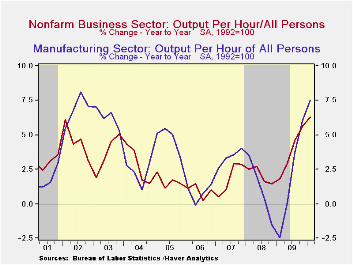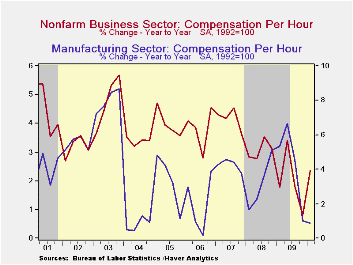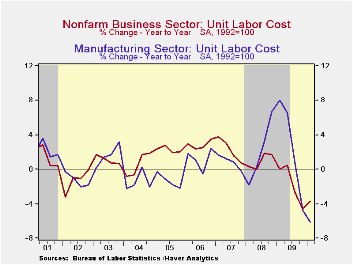 Global| May 06 2010
Global| May 06 2010U.S. Worker 1Q Productivity Growth Moderates, But Still Looks Strong Y/Y
by:Tom Moeller
|in:Economy in Brief
Summary
Growth in worker productivity in the nonfarm business sector slowed last quarter to 3.6% from 6.3% during 4Q. A near-halving of output growth did not prompt as much of a cutback in aggregate hours-worked (employment times hours [...]

Growth in worker productivity in the nonfarm business sector slowed last quarter to 3.6% from 6.3% during 4Q. A near-halving of output growth did not prompt as much of a cutback in aggregate hours-worked (employment times hours worked). Nevertheless, the 6.3% surge in U.S. worker productivity growth during the last four quarters was the strongest since early-1962 (no typo). New technologies, improved work techniques and an improved labor skill-sets have paid off. Productivity last quarter exceeded Consensus expectations for a 2.5% rise.
The slowdown in 1Q productivity occurred as real output growth slowed to 4.4% (3.1% y/y) from 7.0% during 4Q. That was met by a slight acceleration in hours worked to 0.8% (-3.0% y/y) from 0.7%.Growth in compensation costs also accelerated to 1.9% (2.3% y/y). Four-quarter growth in compensation was nearly the slowest since 1995.
The rate of decline in unit labor costs eased during 4Q '09 as compensation picked up slightly. Regardless, the four-quarter decline in costs of 3.7% was the largest on record. That enabled corporate profits to jump by nearly one-third last year.
In the factory sector alone, worker productivity growth also slowed sharply to 2.5% (7.5% y/y) from 6.5% during 4Q '09. The slowdown occurred as output rose an accelerated 7.5% (3.3% y/y) compared to the pickup in hours-worked to 4.9% (-3.9% y/y) following a slight 4Q decline. Compensation fell 1.2% but the y/y change of 0.9% was the weakest since 2006. The combination of lower compensation and the rise in productivity dropped unit labor costs by 3.7%.
The productivity & cost figures are available in Haver's USECON database.


| Nonfarm Business Sector(SAAR,%) | 1Q '10 | 4Q '09 | 3Q '09 | 1Q Y/Y | 2009 | 2008 | 2007 |
|---|---|---|---|---|---|---|---|
| Output per Hour (Productivity) | 3.6 | 6.3 | 7.8 | 6.3 | 3.7 | 2.1 | 1.8 |
| Compensation per Hour | 1.9 | 0.4 | -0.4 | 2.3 | 1.9 | 3.1 | 4.2 |
| Unit Labor Costs | -1.6 | -5.6 | -7.6 | -3.7 | -1.7 | 1.0 | 2.3 |
| Manufacturing Sector | |||||||
| Output per Hour | 2.5 | 6.5 | 14.8 | 7.5 | 1.8 | 1.1 | 3.4 |
| Compensation per Hour | -1.2 | -0.3 | -1.0 | 0.9 | 4.4 | 3.2 | 4.3 |
| Unit Labor Costs | -3.7 | -6.4 | -13.7 | -6.1 | 2.5 | 2.1 | 0.9 |
Tom Moeller
AuthorMore in Author Profile »Prior to joining Haver Analytics in 2000, Mr. Moeller worked as the Economist at Chancellor Capital Management from 1985 to 1999. There, he developed comprehensive economic forecasts and interpreted economic data for equity and fixed income portfolio managers. Also at Chancellor, Mr. Moeller worked as an equity analyst and was responsible for researching and rating companies in the economically sensitive automobile and housing industries for investment in Chancellor’s equity portfolio. Prior to joining Chancellor, Mr. Moeller was an Economist at Citibank from 1979 to 1984. He also analyzed pricing behavior in the metals industry for the Council on Wage and Price Stability in Washington, D.C. In 1999, Mr. Moeller received the award for most accurate forecast from the Forecasters' Club of New York. From 1990 to 1992 he was President of the New York Association for Business Economists. Mr. Moeller earned an M.B.A. in Finance from Fordham University, where he graduated in 1987. He holds a Bachelor of Arts in Economics from George Washington University.






